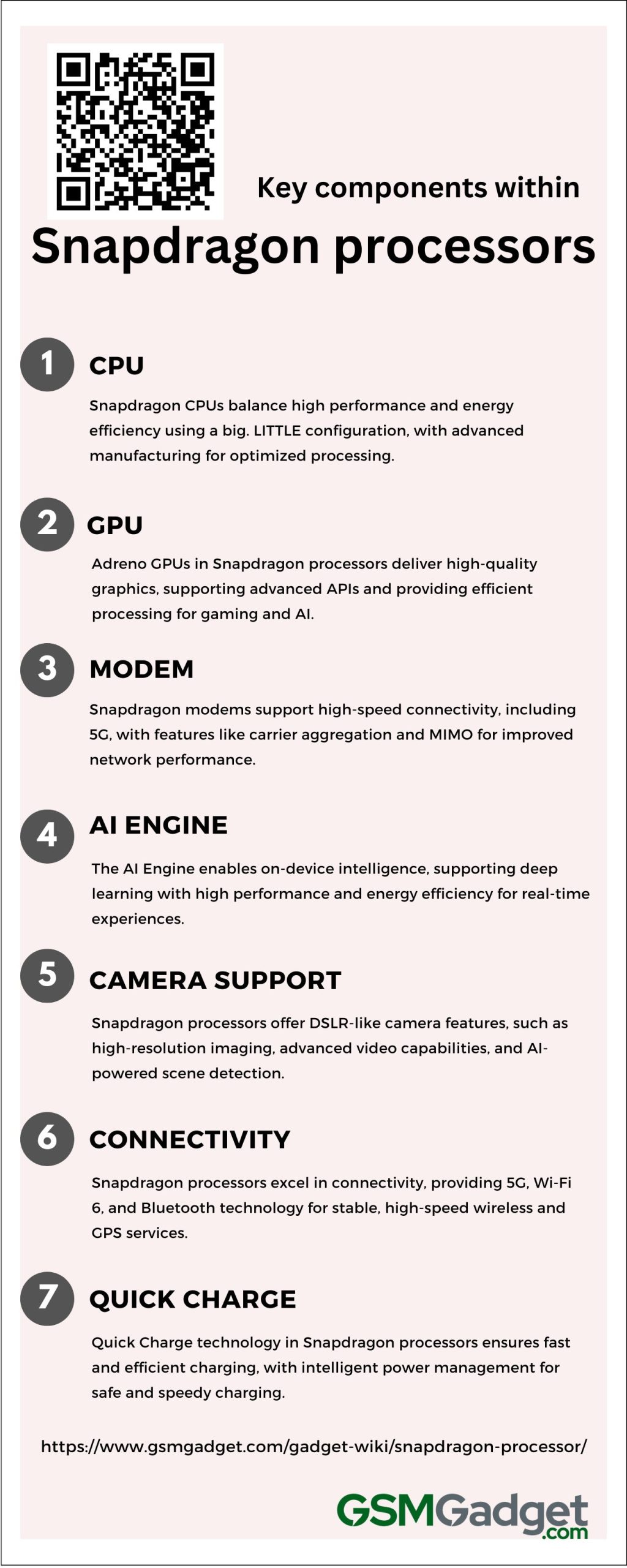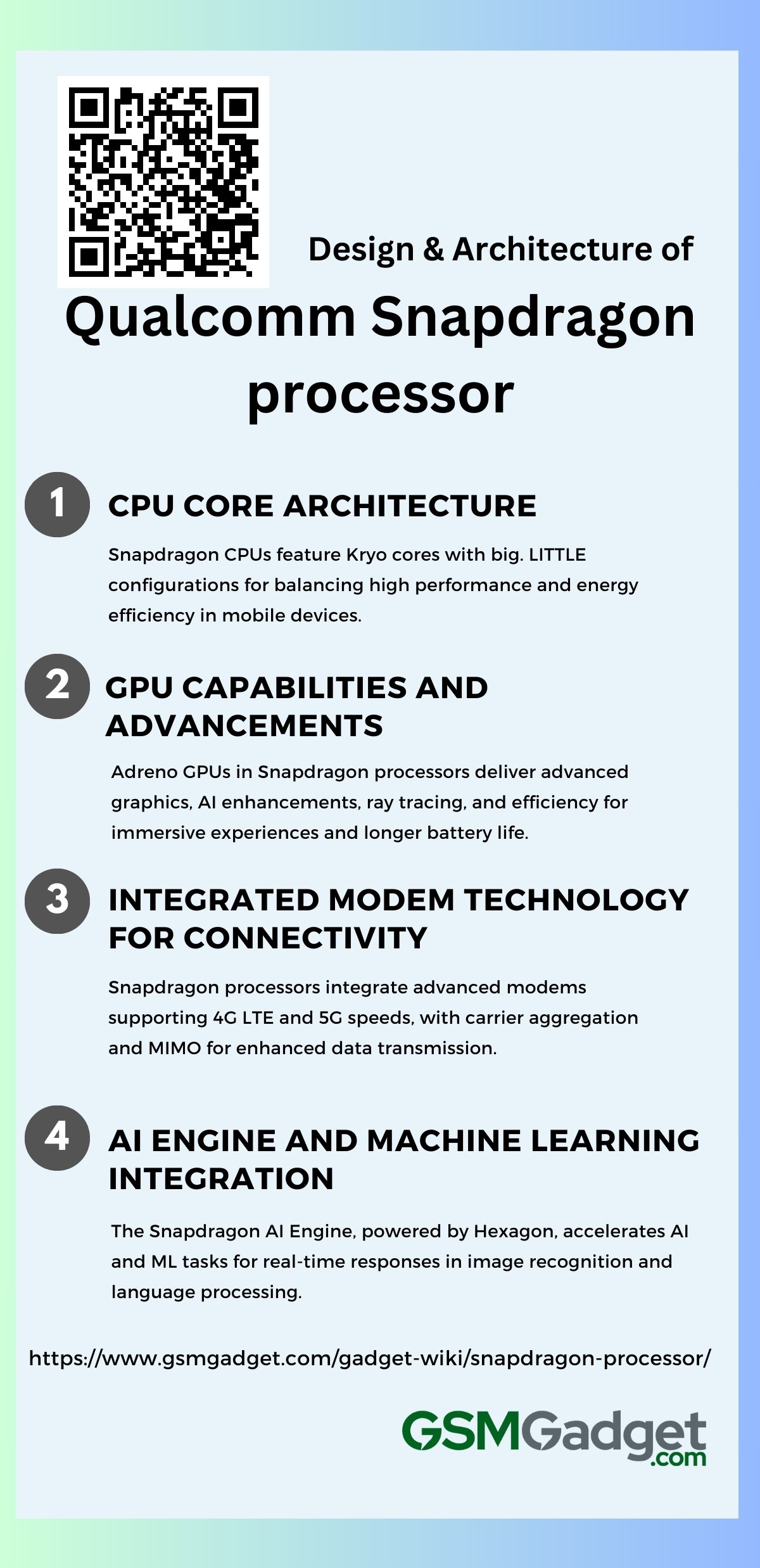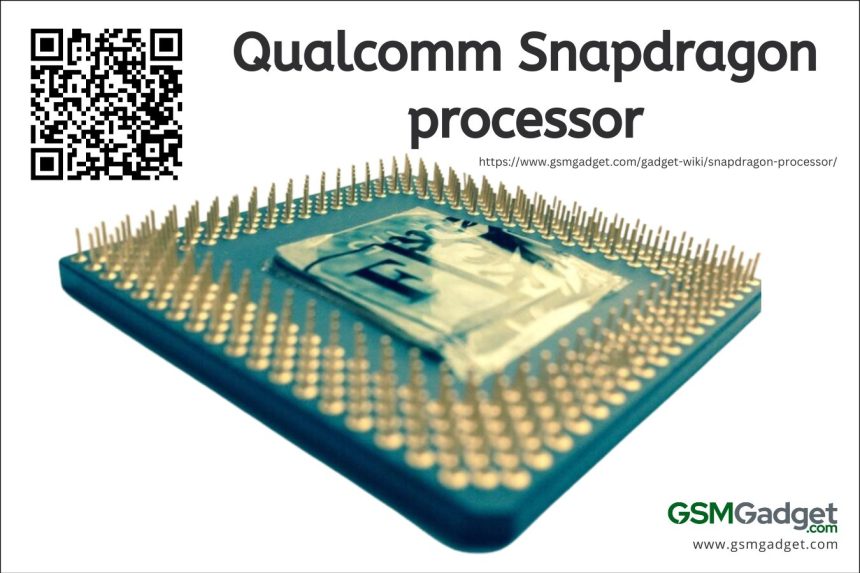The Qualcomm Snapdragon processor, designed and marketed by Qualcomm Technologies Inc., is a cornerstone in mobile technology, powering a wide array of devices from smartphones to automotive systems. Since its inception in 1985, Qualcomm has grown into a global corporation with a hand in semiconductors and telecommunications equipment. Snapdragon’s versatility is evident in its range of applications; it not only drives the central and graphics processing units of phones and tablets, but also enables advanced features, such as AI acceleration, camera capabilities, and integrated 4G LTE and 5G connectivity. This has cemented its reputation for delivering seamless multitasking, impressive graphics, and high-speed wireless communications. The processor is also integral to space exploration, having been used in the Ingenuity Helicopter on Mars, and extends its prowess to the pharmaceutical industry with Snapdragon Chemistry’s continuous manufacturing. The Snapdragon 855 chipset, a recent innovation, is a testament to the brand’s leadership in the field, introducing support for 5G, AI, and extended reality, paving the way for transformative mobile experiences.
Technical specification Qualcomm Snapdragon processor
| Specification | Snapdragon 865 | Snapdragon 888 |
| CPU Configuration | 1x 2.84 GHz Kryo 585 (Cortex-A77) | 1x 2.84 GHz Kryo 680 (Cortex-X1) |
| 3x 2.42 GHz Kryo 585 (Cortex-A77) | 3x 2.42 GHz Kryo 680 (Cortex-A78) | |
| 4x 1.8 GHz Kryo 585 (Cortex-A55) | 4x 1.8 GHz Kryo 680 (Cortex-A55) | |
| GPU | Adreno 650 | Adreno 660 |
| Process Technology | 7nm (N7) | 5nm (N5) |
| Camera Support | Single-camera up to 200 MP | Single-camera up to 200 MP |
| Dual-camera up to 25 MP with ZSL | Triple-camera up to 28 MP with ZSL | |
| Video Capture | 8K at 30 fps, 4K at 120 fps | 8K at 30 fps, 4K at 120 fps |
| Charging Technology | Quick Charge 4+ | Quick Charge 5 |
| Memory Support | LPDDR5 up to 2750 MHz | LPDDR5 up to 3200 MHz |
| LPDDR4X up to 2133 MHz | LPDDR4X up to 2133 MHz | |
| Modem | Snapdragon X55 5G Modem-RF System | Snapdragon X60 5G Modem-RF System |
| Wi-Fi | Wi-Fi 6 (802.11ax), 802.11ac Wave 2 | Wi-Fi 6E (802.11ax), 802.11ac Wave 2 |
| Bluetooth | Bluetooth 5.1 | Bluetooth 5.2 |
| AI Engine | Hexagon 698 | Hexagon 780 |
| Security | Secure Processing Unit (SPU) | Secure Processing Unit (SPU) |
Key components within Snapdragon processors
Snapdragon processors, powering many of today’s leading smartphones, are composed of expertly designed components such as CPU cores, GPUs, DSPs, ISPs, and modems. These elements collaborate to balance power and functionality, enabling devices to manage daily tasks and demanding applications with ease. The intricate design of Snapdragon chipsets plays a critical role in enhancing user experiences by delivering both high performance and efficiency across various applications.

1. CPU
CPU architecture that balances high performance with energy efficiency. Central to these processors is the Kryo CPU, an ARM-based core custom-tailored to maximize processing speeds and minimize power consumption. Snapdragon’s innovative multi-core setup typically employs a big. LITTLE configuration, which dynamically allocates tasks between high-performance and high-efficiency cores based on computational demand. This method conserves battery life by allowing lighter tasks to be handled by efficiency cores, while performance cores deal with more demanding activities, ensuring a smooth user experience. The use of advanced semiconductor manufacturing, such as 7nm or 5nm technology, allows for denser transistor packing, which enhances speed and further improves energy efficiency. In addition to the CPU, Snapdragon processors incorporate the Adreno GPU, Hexagon DSP, and Spectra ISP, supporting a spectrum of capabilities from gaming to AI and camera functionalities, establishing them as a versatile option for a variety of smartphone applications.
2. GPU
Incorporate powerful GPUs, notably the Adreno series, that serve as the core for rendering high-quality graphics on mobile devices. These GPUs enhance visual output, support advanced APIs such as Vulkan and OpenGL ES, and bring features like HDR gaming and physically based rendering to life. They are designed for efficient processing, optimizing power consumption, and heat management to sustain performance. With a focus on parallel computing, the GPU architecture in Snapdragon processors includes shader pipelines, schedulers, and memory components that enable Single Instruction, Multiple Threads (SIMT) execution, boosting performance, energy efficiency, and reliability. This makes Snapdragon-equipped devices a top choice for gaming, artificial intelligence, and virtual reality applications, providing users with smoother gameplay, detailed graphics, and higher frame rates for an immersive and realistic experience.
3. Modem
The Snapdragon X-series modem, an integral component of Snapdragon processors, is engineered for high-speed connectivity and supports a vast spectrum of cellular standards, including 3G, 4G LTE, and the latest 5G networks. It combines hardware and software elements, utilizing Orthogonal Frequency Division Multiplexing (OFDM) and advanced technologies like carrier aggregation to enhance bandwidth and Multiple Input Multiple Output (MIMO) to improve signal quality. These modems are equipped with Ethernet parts, a bridge component, and sophisticated band-spreading techniques for efficient communication in digital and electrical power distribution networks. Additionally, the modem’s ASICs, which contain correlators and address counters, facilitate signal processing while digital interfaces allow for synchronization with RF chips. The synergy of these technologies in Snapdragon processors delivers robust functionality for a myriad of applications, from streaming multimedia to real-time gaming, providing users with fast, reliable data transmission, low latency, and improved network efficiency. Furthermore, features like Qualcomm® FastConnect™ offer superior Wi-Fi and Bluetooth connectivity, ensuring a consistent wireless experience.
4. AI Engine
The AI Engine, central to on-device intelligence, is designed for efficient deep learning processing with an architecture that achieves high performance and energy efficiency. It integrates programmable components with a custom Instruction Set Architecture to support diverse neural network topologies, achieving over 90% utilization. The use of 16b floating point enhances model accuracy, while 1b/2b integer operations allow for high-speed inference. Comprising the Kryo CPU, Adreno GPU, and specialized Hexagon DSP, the AI Engine conducts complex AI tasks such as natural language processing and camera scene detection. These components, along with supporting software frameworks, enable Snapdragon processors to provide real-time experiences like voice recognition and advanced gaming, all with a focus on power efficiency for mobile devices.
5. Camera Support
Camera support systems have evolved with innovative features to enhance photography and videography experiences. Vuillet Jean-François et al. designed a system with a locking ring mechanism for secure camera attachment, while Lee Jae Sun integrated a power supply within the camera support body, eliminating the need for additional tools. Notably, Qualcomm’s Snapdragon processors, equipped with the Qualcomm Spectra™ Image Signal Processor, offer DSLR-like features, including multi-frame noise reduction and zero shutter lag. These processors enable high-resolution imaging and advanced video capabilities such as 4K HDR recording and slow-motion capture at high frame rates. Snapdragon’s high-speed multi-gigapixel processing and advanced ISPs facilitate swift image capture, noise reduction, and improved image stabilization, delivering crisp photos under various conditions. The inclusion of artificial intelligence further refines the camera’s functionality, with smart scene detection and optimized settings. These advancements position Snapdragon processors as pivotal in mobile devices, allowing users to create professional-quality content.
6. Connectivity
Snapdragon processors by Qualcomm stand out for their superior connectivity features, vital for modern mobile devices’ performance. These processors integrate an advanced multi-gigabit 5G modem for high-speed internet access with low latency, boosting mobile broadband experiences. They also support the latest Wi-Fi 6 and 6E standards, ensuring swift and stable wireless connections, and Bluetooth technology for smooth integration with various wireless devices. With precise GPS capabilities for accurate location services, Snapdragon processors offer a complete communication suite. A bridge component within the processors further enhances connectivity by facilitating communication between different parts and minimizing port collisions, creating a seamless experience for users and maintaining Snapdragon’s leadership in mobile processor connectivity.
7. Quick Charge
Snapdragon processors, celebrated for their robust performance in mobile devices, are equipped with Qualcomm’s proprietary Quick Charge technology, which enables fast and efficient charging. Central to this system is the power management integrated circuit (PMIC), which regulates power delivery in tandem with the processor. The Quick Charge mechanism features a charging current generator, including a rectifier and high-frequency inverter, a timer circuit for precision based on battery voltage, and automatic voltage adjustment capabilities. Algorithms within the processors manage power levels and heat dissipation, while stationary capacitors within the charging unit improve the effectiveness of mobile capacitors by facilitating step-by-step connection and voltage equalization. Adapters in the system adjust charging voltage and current via a control unit and PWM drive module, ensuring a quick and safe charging process. This technology supports a range of devices and power levels through intelligent power negotiation, continuously enhancing charging speed and energy efficiency with each iteration, from Quick Charge 1.0 to the latest version, providing users with reduced charging times without compromising battery health or device safety.
History and Evolution of Qualcomm Snapdragon processor
Since the launch of its first Snapdragon processor in 2007, Qualcomm has been changing the mobile technology landscape with its innovative system-on-chip (SoC) designs. Known for their integrated CPU, GPU, and modem, Snapdragon processors have set industry standards for performance, energy efficiency, and advanced features, such as AI acceleration and 5G connectivity. Models like the 801, 835, 845, and the recent 8 Gen 1 have pushed the boundaries of mobile processing capabilities. Qualcomm’s dedication to research and development has not only enabled the Snapdragon series to power a diverse range of devices, from smartphones to automotive systems but has also led to their use in space exploration, such as on the Ingenuity Helicopter on Mars. This evolution highlights Qualcomm’s influence on mobile computing, as Snapdragon SoCs continue to deliver robust performance and support the ever-increasing demands of modern technology.
Design & Architecture of Qualcomm Snapdragon processor
The Qualcomm Snapdragon processor is a pinnacle of mobile technology, combining sophisticated design and advanced multi-core configurations for high performance and energy efficiency. It features integrated 5G, AI acceleration, and dynamic camera processing, making it versatile across smartphones and automotive systems. Snapdragon’s cutting-edge system-on-chip (SoC) design ensures fast, multitasking capabilities while optimizing battery life, setting industry standards for mobile processing power.

1. CPU core architecture
CPU core architecture which ensures a harmonious balance of high performance and energy efficiency. Central to its innovative design are the Kryo CPU cores, semi-custom derivatives of ARM Cortex technology, tailored to enhance both speed and power efficiency. Snapdragon processors employ a multi-core setup, featuring a strategic mix of high-performance and high-efficiency cores in a big. LITTLE configuration, enabling dynamic adjustment to computational needs for optimal power use and thermal control. Integrated within this architecture are essential components like the Adreno GPU, Hexagon DSP, and Spectra ISP, all united on a single chip. Each generation of Snapdragon chipsets embraces cutting-edge semiconductor manufacturing advancements to further elevate mobile computing capabilities, ensuring devices that are not only faster and more powerful but also exceptionally battery-efficient.
2. GPU capabilities and advancements
The forefront of GPU technology, leveraging General Purpose Graphics Processing Units (GPGPUs) like the Adreno series to deliver exceptional computational performance for a variety of tasks beyond traditional graphics rendering. These processors support the latest graphics APIs, and their GPUs feature hardware-accelerated ray tracing for realistic lighting, along with AI-enhanced graphics for applications ranging from gaming to augmented reality and professional photography. Each new Snapdragon GPU iteration offers increased efficiency in rendering, smoother gameplay, and compatibility with advanced display technologies, while optimizing power consumption to extend device battery life. The integration of AI within the GPU architecture also enables real-time language translation and superior photography features, contributing to the rich, immersive experiences expected from today’s top-tier smartphones and devices.
3. Integrated modem technology for connectivity
The Snapdragon 888 and 765, represent the forefront of modem technology with their advanced 5nm and 7nm EUV FinFET designs, providing premium-tier performance, integrated 5G, and AI capabilities. The Snapdragon X-series modem at the core of these processors supports multi-gigabit 4G LTE and 5G speeds, ensuring efficient communication with reduced latency and power consumption. Features like carrier aggregation, 4×4 MIMO, and Qualcomm’s Signal Boost technology enhance signal quality, while the integration of the modem within the SoC streamlines smartphone design and promotes energy-efficient data transmission. This is pivotal for mobile internet and IoT applications. Qualcomm’s commitment to innovative connectivity means that Snapdragon-equipped devices offer not only faster but also smarter and more reliable user experiences, for activities such as streaming, gaming, and browsing in the rapidly evolving mobile landscape.
4. AI Engine and machine learning integration
The Qualcomm Snapdragon processor’s advanced AI Engine, powered by the Hexagon Processor, is engineered to enhance machine learning performance with efficient execution of complex computations at reduced power consumption. Its architecture is designed to accelerate a wide array of AI algorithms, allowing for real-time responses in applications such as image recognition, natural language processing, and gaming. Utilizing heterogeneous computing, the Snapdragon processor distributes tasks across the Kryo CPU, Adreno GPU, and Hexagon DSP to maximize their capabilities. This design supports various neural network frameworks, offering versatility for different AI applications. With a comprehensive AI software stack, developers are equipped with robust tools to develop applications that learn and adapt, thus improving user experiences across devices, from smartphones to automotive systems. The Snapdragon’s integration of AI and ML fosters the creation of mobile applications that are not only intelligent but also capable of evolving with user interactions.
